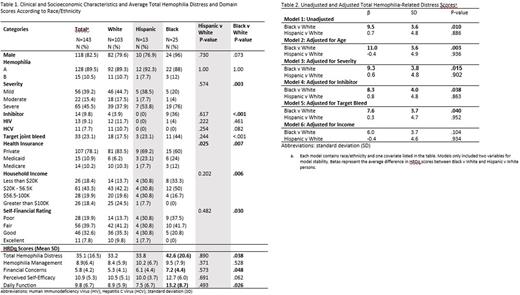Abstract
Introduction: Recently, a Hemophilia-Related Distress Questionnaire (HRDq) was validated (Kempton et al. Haemophilia 2021). Hemophilia-related distress has been shown to be higher among people with less education and those who were unemployed. However, differences in hemophilia-related distress according to race/ethnicity have not been previously described but are important to explore to identify potential health inequities.
Objective: To examine Hemophilia-related distress according to race/ethnicity.
Methods: This cross-sectional study was a planned secondary analysis of HRDq validation study data. Adults aged ≥18 years with Hemophilia A or B were recruited from one of two hemophilia treatment centers between July 2017 and December 2019 Only patients who spoke English were eligible for the study. The HRDq includes 24-questions across four domains: 1) hemophilia management, 2) financial concerns, 3) perceived self-efficacy, and 4) daily function. There were six responses for each question: (Never, A little bit, Sometimes, Often, Most of the Time, Always) scored from 0 to 5, respectively. Higher scores indicate increased hemophilia-related distress, with a total maximum summary score of 120. Race/ethnicity was self-reported, and patients were grouped as Hispanic, White (non-Hispanic) and Black. Total HRDq and domain-specific scores were compared with independent T and ANOVA tests. Unadjusted and multivariable linear regression models were used to examine potential mediators of race/ethnicity and HRDq scores. Multivariable linear regression models included race/ethnicity and one other variable (eg: severity) for model stability and to accommodate the study's relatively small sample size.
Results: Among 149 participants enrolled in the study, 143 completed the HRDq and were included in analyses. Approximately, 17.5% of participants were Black, 9.1% were Hispanic and 72.0% were White. Most were male (82.5%) and had Hemophilia A (89.5%), and the average age was 36.7 years [standard deviation (SD)=14.7 years] (Table 1). Approximately 45.5% of participants had severe disease; these proportions were higher among Black (76.0%) and Hispanic (53.8%) participants than White participants (37.9%). Over a third of Black participants had an inhibitor, compared to none of Hispanic participants and <5% of White participants. Self-reported household income was significantly lower among Black compared to White participants.
HRDq scores ranged from 2 to 83, with a mean of 35.1 SD= 16.5 and a median of 31. The average HRDq score was significantly higher among Black (mean=42.6 SD=20.6; p-value=.038) participants compared to White (mean=33.2, SD=14.9) participants (Table 1). There were no differences in Hispanic (mean=33.8, SD=16.7, p-value=.89) participants relative to White participants (Table 1). In domain analyses, financial concerns and daily function distress scores were significantly higher among Black than White participants (Table 1). When accounting for inhibitor status or severity, the significantly higher HRDq scores among Black relative to White participants remained (Table 2). However, after accounting for household income, there was no statistically significant difference in Black v White participants' overall HRDq scores (β=6.0 SD=3.7; p-value=0.10).
Conclusions: Black participants reported higher hemophilia-related distress than White participants, with significantly greater daily functioning and financial concerns. Differences in household income mediated higher distress scores in Black compared to White participants, highlighting the critical need to better understand the impact of social determinants of health in persons with hemophilia. Further research on how racial/ethnic differences in hemophilia-related distress influence disease self-management and outcomes are needed.
Disclosures
Buckner:uniQure, Inc: Consultancy, Honoraria, Membership on an entity's Board of Directors or advisory committees; BioMarin: Consultancy, Membership on an entity's Board of Directors or advisory committees; Tremeau Pharmaceuticals: Consultancy, Membership on an entity's Board of Directors or advisory committees; Novo Nordisk: Membership on an entity's Board of Directors or advisory committees; CSL Behring: Membership on an entity's Board of Directors or advisory committees; Genentech: Membership on an entity's Board of Directors or advisory committees; Spark: Membership on an entity's Board of Directors or advisory committees; Sanofi: Membership on an entity's Board of Directors or advisory committees; Bayer: Membership on an entity's Board of Directors or advisory committees; Pfizer: Membership on an entity's Board of Directors or advisory committees; Takeda: Membership on an entity's Board of Directors or advisory committees. Cafuir:BioMarin: Membership on an entity's Board of Directors or advisory committees. Kempton:Grifols: Honoraria; Novo Nordisk: Consultancy, Research Funding; Genentech: Consultancy.
Author notes
Asterisk with author names denotes non-ASH members.


This feature is available to Subscribers Only
Sign In or Create an Account Close Modal